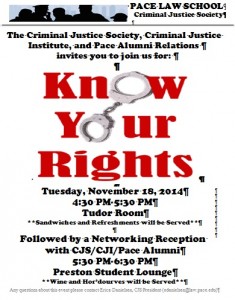The Newburgh Sting – HBO Documentary Screening with Director and Attorneys
On February 3, 2015 at 6:00 pm in the Moot Court Room of the Gerber Glass building at Pace Law School, the Criminal Justice Institute and Criminal Justice Society at Pace Law School will host a screening of the HBO Movie The Newburgh Sting, with the film’s director, David Heilbroner. This film, which was shown at the 2014 Tribeca Film Festival, tells the story of United States v. Cromitie, a 2013 terrorism case that arose out of Newburgh, New York and was tried in White Plains. The defendants were young men who joined the efforts of an undercover FBI agent posing as a terrorist in his plan to bomb a synagogue in Riverdale. United States v. Cromitie, 781 F. Supp. 2d 211 (S.D.N.Y. 2011). It has been said to involve the most outrageous government entrapment methods of any post-9/11 terrorism case. But did it? Or was it rather a successful prosecution of young men willing to join the efforts of an apparently well-armed, well organized terrorist? The jury took eight days to render its verdict, rejecting the entrapment defense. The defendants were sentenced to twenty-five year prison sentences. The Second Circuit affirmed in a divided opinion. United States v. Cromitie, 727 F.3d 194 (2d Cir. 2013).
After the screening, the attorneys involved in the case will join the director for a panel discussion addressing the many provocative issues raised by the film. Among these issues are:
- Were the defendants entrapped as a matter of law or were they properly convicted for willingly joining a terrorist plot?
- How can the government discover and prosecute people who are not members of a known terrorist organization but who are willing to join a plot to bomb US targets?
- What are the differences between a film director trying to show “what happened” and a lawyer trying to prove “what happened” in a courtroom?
- What do those differences say about our criminal justice system?
- What do these lessons mean for lawyers and law students?
Several of the attorneys taking part in the panel discussion are graduates of Pace Law School: Susanne Brody is a 1988 graduate and an attorney with Federal Defenders of New York; Heather Bird is a 2010 graduate and is an attorney in Toronto, Canada; Gonul Aksoy is a 2008 graduate and an attorney with a White Plains firm; and Giovanni Rosania is a 2006 graduate also in private practice in White Plains. The panel also includes two well respected and well known criminal defense lawyers who were defense counsel in the case: Sam Braverman of Fasulo Braverman & Di Maggio, LLP, President of the Bronx County Bar Association, and Kerry Lawrence of Calhoun & Lawrence, LLP, a former Assistant United States Attorney.
The Pace Criminal Justice Institute generates educational opportunities for Pace Law students and promotes interdisciplinary collaboration between scholars, policymakers and practitioners in and outside the Pace community. The Institute supports and encourages creative research, teaching, and discussion concerning the theory and practice of Criminal Law. The Institute created and maintains an online forum, Pace Criminal Justice Blog, fostering and encouraging the discourse of important current issues in domestic and international criminal law and procedure.

